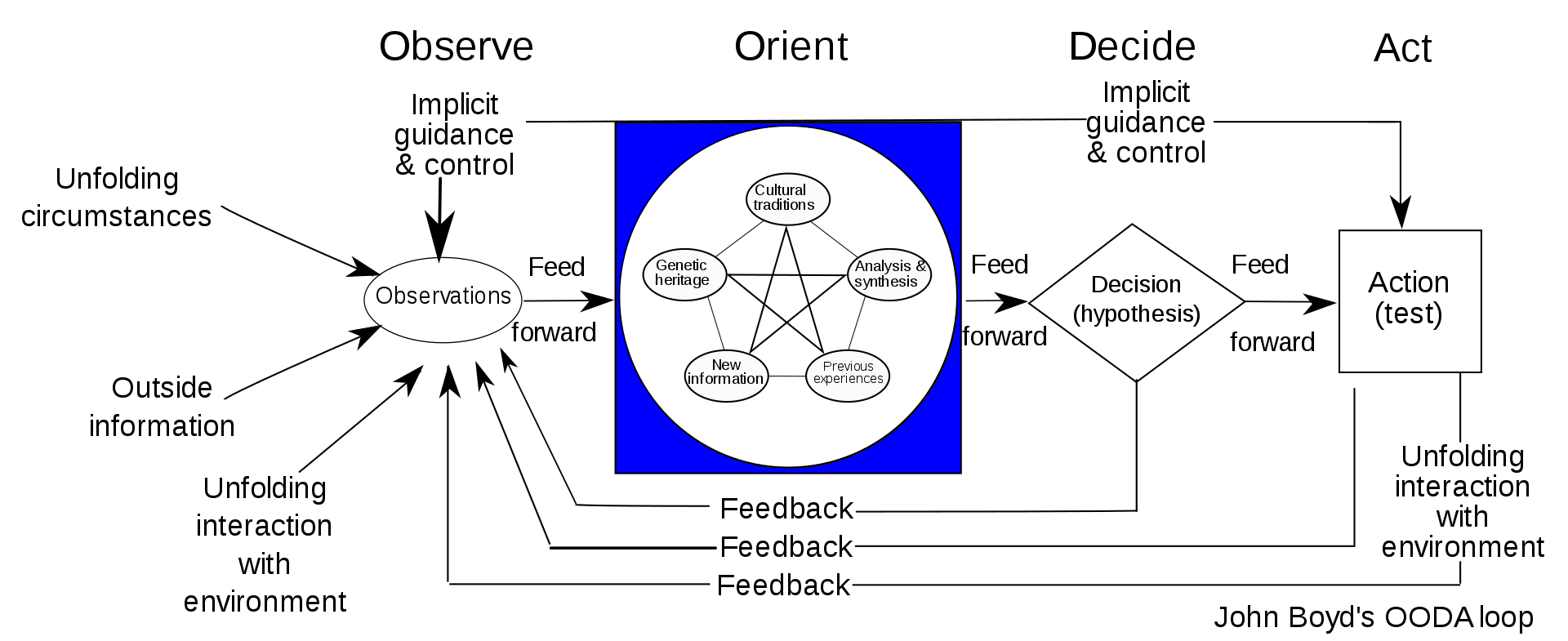Introduction: What is the OODA Loop?
The OODA Loop, also called the Observation-Orientation-Decision-Action Loop1, is a decision cycle that is used to make decisions in high-pressure situations. It is credited to Air Force Colonel John Boyd who used it to describe a decision making cycle in the context of critical decisions made in combat.2
The OODA Loop consists of four steps:
- Observation - taking in information about the environment and surroundings.
- Orientation - comprehending this information and making sense of it.
- Decision - choosing an appropriate course of action based on what has been observed and understood so far.
- Action - The final step that requires putting the decision into motion in order to achieve a desired outcome or goal

Major limitations to the time it takes to complete a full cycle of the OODA Loop include the speed of human cognition, and our ability to observe data from our environment and understand it. In the classic industrial manufacturing text “The Goal” Eli Goldratt describes a Theory of Constraints that explains every end-to-end process is limited by bottlenecks. In the 21st century one of the principle bottlenecks in our sensemaking & decision making process is the speed of human thought.
Bottom Line: In this present age of AI and machine learning organizations that can reduce their cycle time and make better decisions that are also faster decisions will rapidly out perform slower organizations that lack technology enabled decision making.
Observation Phase - Developing Awareness of the Environment Through Data
The Observation Phase is the first phase of the OODA loop. It is the process of developing awareness of the environment through data. The Observation Phase is about collecting, analyzing, and interpreting data to determine what’s going on in a given environment.
The Observation Phase can be broken down into three steps:
Collecting Data - Data collection occurs when a person or system gathers information from its environment, from sensors or from other sources.
Analyzing Data - This step involves sorting through the collected data and determining which pieces are relevant to understanding what’s going on in an environment and which pieces are not.
Interpreting Data - The final step in this phase is to use that information to create a coherent picture of what’s going on in.
Orientation Phase - Driving Focus On the Most Important Things
The orientation phase is when the team is getting to know each other and when the team starts driving focus on the most important things.
Anomaly detection is also a part of this phase. The goal of anomaly detection is to detect any abnormalities or risks that might be present in the process or product.
Decision Phase - Make a Decision on What Actions to Take
The decision phase is the most important phase in the OODA loop. It’s where you make a smart decision on what actions to take.3
There are two risks that you need to consider when making decisions. The first risk is the risk of doing nothing, which is also known as the status quo bias. The second risk is the risk of making a wrong decision, which can be costly and impact your organization in many ways.
Action Phase - Implement Actions and Re-start the OODA Loop
The OODA loop is a process that is used in military strategy. It is a decision-making model that can be used to improve the efficiency of any business process. The cycle time of the OODA loop can be decreased by implementing decisive actions and restarting it.
Decisive action: Decisive action is the implementation of an action that will result in an immediate change in the situation and conditions for success.
Re-start: Re-starting the OODA loop means to go back to step one and start over again with new information, data, or observations so as to take advantage of any improvements made to previous iterations.
Resources
-
OODA Loop definition on Wikipedia https://en.wikipedia.org/wiki/OODA_loop ↩︎
-
Prescient quote from John Boyd in 1996 about the need for OODA loops https://www.danford.net/boyd/essence2.htm ↩︎
-
Decision Cycle definition on Wikipedia https://en.wikipedia.org/wiki/Decision_cycle ↩︎